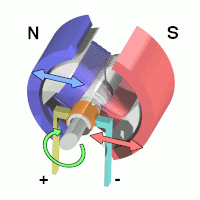
Photo from wikipedia
Many kinds of commutation methods have been proposed to reduce the noise and vibration in a switched reluctance motor (SRM). One of these is well known as the two-stage commutation… Click to show full abstract
Many kinds of commutation methods have been proposed to reduce the noise and vibration in a switched reluctance motor (SRM). One of these is well known as the two-stage commutation method. However, it has a defect that is principally revealed when an SRM is operated at high speed and under a high-load condition. This study investigated why vibration reduction based on two-stage commutation does not work through an electromagnetic-structural coupled analysis using a finite element method and mathematical analysis of the exciting force in a 0.4 kW four-phase 8/6 SRM. Based on the investigations, a modified method is proposed to reduce the vibration and noise independent of the operating condition. Experimental studies using the tested SRM demonstrated that the proposed modified control method could reduce the noise and vibration at high speed and under a high-load condition.
Journal Title: IEEE Transactions on Industry Applications
Year Published: 2018
Link to full text (if available)
Share on Social Media: Sign Up to like & get
recommendations!